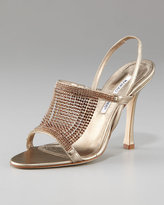
Manolo Blahnik Crystal & Napa Slingback. Price per pair? $1595
I was 21 when I first encountered Carrie Bradshaw, and, as a middle-class girl from Maine, it took me some time to get used to her designer shoe habit. I had never heard of Manolo Blahnik or Christian Louboutin, and I had certainly never heard of regular people spending $400 on footwear. The fact that Carrie didn’t make a ton of money yet still purchased such expensive heels struck me as false, a bit of Hollywood nonsense in a show with an otherwise realistic emotional core. The longer I lived in New York though, the more women I met who made clothing and shoe purchases disproportionate to their salaries. When you walk by the windows at Bergdorff’s on a daily basis, you can’t help but begin to absorb—and appreciate—a bit about high fashion. Plus, if there’s ever a place to live out your fashion fantasies, this is it. This is the city that bred the Naked Cowboy and the gentleman on 7th Avenue who wears flashlights in his super-stretched earring holes. So I’ve come to defend the realism of Carrie’s wardrobe, especially when considering that she had a rent-controlled apartment, no children, and, as we learn in season 4, no savings.
What is not realistic however, at least in 2011, is paying a mere $400 for designer shoes. Nowadays, $400 is a quaint, decade-old figure that will barely get you one high-end shoe, let alone two. For example, the most boring pair of Manolos on the Neiman Marcus website, the pair you’d reluctantly fish out of the back of your closet for a last minute job interview as a bank teller, are listed at $625. The first fun pair, the ones I’d see myself throwing on and wearing to Bar Tabac in an effort to prove how young and spontaneous I still am, are listed at $1595. That’s three times more than Carrie’s average.
On August 3rd, the New York Times reported on rising prices in the world of luxury shopping:
“Neiman Marcus has sold out in almost every size of Christian Louboutin “Bianca” platform pumps, at $775 a pair….Many high-end businesses are even able to mark up, rather than discount, items to attract customers who equate quality with price. ‘If a designer shoe goes up from $800 to $860, who notices?’ said Arnold Aronson, managing director of retail strategies at the consulting firm Kurt Salmon, and the former chairman and chief executive of Saks….”
Like with everything else, popularity rises and prices follow. Remember when Magnolia Bakery was a cute little mom-and-pop shop on West 11th Street? When they provided midnight snacks for drunken village revelers? In 2005, Magnolia charged $1.75 for a cupcake. In 2011, normal inflation rates would mandate an increase to $2.02, but the bakery now charges a whopping $3.00. In addition, the cute little mom-and-pop shop has been purchased by a totally different mom and totally different pop who have gone on to open five more Magnolia outposts, including one in Dubai. Magnolia Bakery is officially a tourist trap.
As I observe more and more of my tourists clamoring for Louboutins, Blahniks, and Choos, the more I think these items may be headed the way of the cupcake and becoming too popular—and expensive—for their own good. If the original Carrie lived in this day and age, would she roll her eyes at tourists ogling $1500 heels? In one of the only intelligent exchanges in the Sex and the City movie, Miranda asks the girls why they stopped drinking Cosmopolitans, and Carrie replies, “Because everyone else started.” With that same sentiment in mind, I can’t help but wonder if overpriced shoes are really just…over.
Emily Sproch is a writer and a “Sex and the City” tour guide. Each Friday, she chronicles the fine line between reality and fiction in her column “Almost Carrie.”










